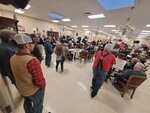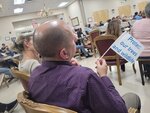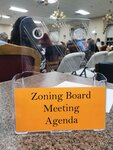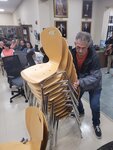Editor’s Note: This is the first installment of a series looking at the newest iteration of the proposed Winsor Avenue solar farm. Look for part two in next week’s edition. The series is expected to conclude following the Nov. 2 continuation of the Zoning Board special use permit hearing.
This item is available in full to subscribers.
We have recently launched a new and improved website. To continue reading, you will need to either log into your subscriber account, or purchase a new subscription.
If you are a current print subscriber, you can set up a free website account by clicking here.
Otherwise, click here to view your options for subscribing.
Please log in to continue |
|





Editor’s Note: This is the first installment of a series looking at the newest iteration of the proposed Winsor Avenue solar farm. Look for part two in next week’s edition. The series is expected to conclude following the Nov. 2 continuation of the Zoning Board special use permit hearing.
“If we come across a turtle, or any wildlife, we’ll pick it up and move it,” testified Joseph McCue.
The crowd burst into laughter — nervous, angry, loud laughter. One guy applauded. Zoning Board Chairman Thomas Lopardo banged the gavel up front. He called for order.
Green Development made practically the same pitch in April 2022.
Most of the same witnesses testified last year. Most of the same abutters were notified and packed the Johnston Senior Center, looking for answers and representation.
The scope has decreased slightly, but even that’s up for debate, following the first round of testimony before the Johnston Zoning Board last Thursday night.
The Cranston-based solar development company’s attorney, John O. Mancini, called his witness, McCue, the owner of McCue Environmental, a wetland consulting firm, to the front of the room.
“As you know, there will be cutting of trees, and these will displace the species that are using them,” McCue told the board and the crowd at his back. “They can relocate either on-site; there’s a large area of forest habitat off-site as well. But, we try to minimize that impact.”
Planting Panels
Around 160 forested acres have been targeted for the installation of nearly 50,000 solar panels — a 19 Megawatt (MW) solar field — at 118 Winsor Ave. (AP 59, Lot 15) in northwest Johnston, about a half-mile from the Smithfield and Scituate town borders.
Green argues the 19MW proposal (down 5 MW from their previous 24MW proposal) is a “20% reduction in overall panel surface area.” Landry, however, argued the total site coverage will actually be closer to a mere 5% reduction in project scope.
The proposed site, zoned for residential use, includes a historic farmstead and agricultural fields on the top of Sikkibunkiaut Hill, a Rhode Island Historical Cemetery and isolated pockets of wetland.
Neighbors have formed an opposition group — Stop Johnston Solar. They hired an attorney, Matt Landry, to represent them in court and before the Zoning Board.
The Zoning Board members — Lopardo, and members Anthony Pilozzi, Joseph Anzelone, Charles Ainabe and Richard Fascia; as well as alternates Dennis Cardillo and Albert Colannino — sat silently throughout the testimony. They asked no questions.
Instead, Landry asked Green Development’s witnesses questions.
Lopardo occasionally chastised the loudest in the crowd.
“Do you want to stay here?” He shouted at vocal objectors in the audience.
As the meeting began, he spoke against jeers as he announced the meeting would conclude after three-and-a-half hours Thursday night, and continue on Nov. 2, for three-and-a-half more hours.
“They're trying to wear us down,” sniped an attendee in the back of the room.
Johnston resident Paul Francis played impromptu emcee, grabbing the lectern when he objected to the proceedings. Francis demanded shorter testimony from Green Development witnesses and urged the Zoning Board to listen to the residents and allow residents to ask questions. His pleas were briefly considered by the board, but the Solicitor Joseph Ballirano, advised against taking a vote.
Back to the Turtles
McCue testified that his firm would help clear-cutters avoid wildlife casualties. He introduced the crowd to the term “turtle sweeps.”
“So some of the things we do …” McCue said. “We can schedule the cutting of trees. We can try to cut the trees outside of any general breeding seasons for wildlife. Typically the winter months are a really good time to perform that activity.”
But, “outside of that,” McCue suggested “turtle sweeps.”
“We’ve done this on some projects where we perform wildlife sweeps —um, turtle sweeps,” McCue said.
“On each day of cutting,” McCue and his team will physically pick up and move turtles (and other found animals) out of the way of heavy machinery.
“A big part of this project, we are basically removing trees, but we’re gonna add pollinator habitat,” McCue said. “So we’re losing one habitat type, but we’re gonna switch it with another one. Pollinator seed mixes contain wildflower, and that’s very beneficial for bees, butterflies and birds.”
The current woodland ecosystem may be replaced, in culverts and catch basins.
“They’re constructed for stormwater, but the reality is they do offer habitat for wildlife and aquatic species,” McCue said. “Many projects that I monitor, for detention basins, within just a few months, they can attract waterfowl, amphibians — it’s inevitable that they will find them.”
Mancini asked McCue, in regards to “environmental impact,” whether the “granting of the special use permit would be environmentally detrimental to the orderly growth and development of the town of Johnston.”
“Uh, yeah, I don’t believe this project will be detrimental,” McCue answered.
A man in the audience shouted, “Liar!” The crowd reacted.
We’re leaving a lot of land as-is … we’re not just creating impervious area,” McCue said. “We’re adding plant species, we’re adding pollinator mixes. We’re cutting one habitat type, but we are replacing it with a habitat type.”
Mancini asked McCue if the impact would be the same for a “residential development.”
“No,” McCue replied. “You have impervious surfaces. With residential you have structures … you’re still cutting land, but you’re not letting … you’re putting structures … you’re putting impervious pavement and other structures that wildlife can’t use.”
McCue testified that the project would be “environmentally compatible” with surrounding properties.
The Turnout
Johnston residents packed the meeting room Thursday night. They filled up all the chairs and more were wheeled into the room.
Johnston Fire Marshal Tom Marcello arrived after the meeting started. He circulated around the room, counting meeting attendees. He spoke to the police detail officer and Town Planner Tom Deller about the maximum occupancy.
Marcello said he counted 179 people, but max occupancy is “224 seated.” No one had to leave.
Next Week: The Johnston Sun Rise will take a look at the key term “structure,” and how it applies to solar development. Email Editor Rory Schuler at rorys@rhodybeat.com if you have letters to the editor, comments, tips or questions. Check out the links below to catch up on the rest of the series.
WINSOR FARM REDUX PART 1
WINSOR FARM REDUX PART 2:
WINSOR FARM REDUX PART 3:
Comments
No comments on this item Please log in to comment by clicking here